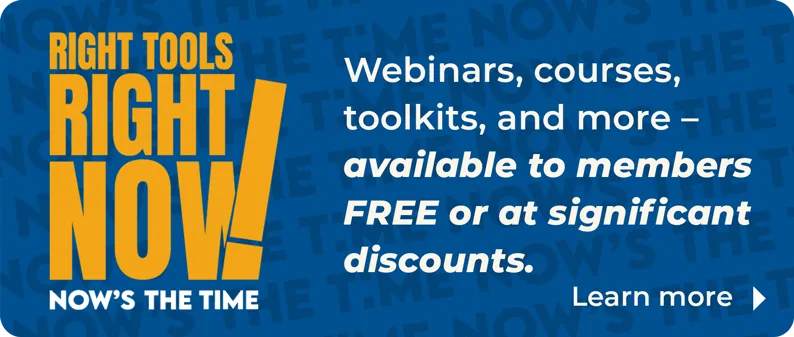Following the New Mandatory Core Standards for Associations of REALTORS®
“By instituting a set of core standards for every one of our 1,400 local and state associations, we take a giant step forward in ensuring that we reach our goals together,” says National Association of REALTORS® President Steven Brown. “Only as a united association with common goals and a common vision are we stronger.”
In early 2014, Brown convened a Presidential Advisory Group of association executives to determine just what those core standards should be. The standards developed by the Organizational Standards PAG—with feedback from AEs across the country—were approved in May by the NAR Board of Directors.
Consisting of six components—Code of Ethics, advocacy, consumer outreach, unification, technology, and financial solvency—the standards will require some associations to institute new programs and practices. Yet, many associations are close to meeting these standards and will only need to comply with the reporting criteria, says Andrea Bushnell, chair of the standards PAG and CEO of the North Carolina Association of REALTORS®.
“The goal of the standards is to ensure that every member is provided with the services they deserve and that every association is contributing to the strength of the organization as a whole,” Brown says.
By June 30, 2015, every local and state REALTOR® association is obligated to prove its compliance with the six new minimum service and organizational criteria. A charter revocation procedure will be initiated for associations that are not compliant by the deadline.
“Hopefully, there won’t be any charter revocations,” NAR CEO Dale Stinton says. “Our intent is for every associations out there to meet these core standards in one way or another.”
The initiative has a $20 million budget, all of which is earmarked to help associations meet the standards.
“We know that there will be mergers,” says standards PAG member Christine Todd, CEO of the Northern Virginia Association of REALTORS®, “but also more consolidation of resources, both human and financial, that will give the associations the resources they need to do their jobs.”
Associations can share services to meet these standards, hire outside firms, merge with other associations, or opt to become a chapter of another association.
“I believe we now have not just an opportunity but an obligation to use our collective resources towards winning legislative issues and legal challenges, securing the value of our brand to the public, and providing opportunities for increasing the professionalism of our membership,” says standards PAG member Cindy Butts, CEO of the Connecticut Association of REALTORS®. “If this PAG plays even a small role in bringing us all toward working together in the big fights being waged against our industry, it will have been worth any effort to get there.”
The standards printed in the following pages are the vision. The work underway now at the national association and among its volunteer committees is to develop a clear definition of what, exactly, is required and how associations comply, Stinton says. NAR is gathering existing resources and developing new ones, training facilitators, posting updates and FAQs on nar.realtor, and fielding questions. The online reporting system where associations will detail how they’ve meet the standards’ criteria is expected by November.
Small associations may be thinking, “How can we possibly do all this?”
“You can,” says Bushnell. “With staff and volunteer participation, and the assistance of NAR and your state, every association has the ability to make it happen.”
How to Get Started
The first step is to download and familiarize yourself with the standards and the compliance criteria posted at nar.realtor. Highlight the areas where you’re already meeting the requirements and circle the areas where you’ll need to develop a new event, practice, or document.
NAR’s resources are vast and each state will also have a menu of services available to local associations. Communicate the standards to your leadership and volunteers in a way that highlights available opportunities, both financial and other. Talk with neighboring associations about collaborating on programs and events to meet the standards. Eventually, meeting these core standards on an annual basis will become routine.
Electronic Reporting Platform
Compliance with the standards has to be made as clear, objective, and simple as possible, says Cliff Niersbach, NAR associate general counsel charged with implementing the core standards initiative. To that end, an online reporting platform, in development at NAR, is expected to include check boxes and data fields and enable associations to attach documents. The online system will streamline compliance reporting, ensure that all criteria have quantifiable measures, and eliminate subjectivity.
Advisers, Funding, & Incentives
The NAR Board of Directors approved up to $20 million to support implementation of the core standards: $5 million to help associations create or update their business or strategic plan; $3 million to assist states with compliance; and $12 million to assist associations that choose to merge, consolidate, dissolve, or become a chapter or council of another association.
Grants of $2,500 to $5,000 will be available to associations to develop a strategic plan or to enhance an existing strategic plan. Funds can be used for any purpose the association deems appropriate, including facilitator fees, meetings and facilities, administrative expenses, travel expenses, etc.
Grants will be disbursed after the strategic plan has been completed and submitted to and approved by NAR. Grants will be based on the number of REALTOR® members at $10 per member, with a minimum grant of $2,500 regardless of association size. Grants will be available for strategic plans created or enhanced between May 17, 2014, and June 30, 2015.
NAR-trained facilitators are available to guide associations through the process. NAR invited experienced association management professionals to apply to attend specific core standards facilitator training in Chicago in July. Participants are listed in the facilitator database on nar.realtor. Associations can choose from these facilitators, use a facilitator of their own choice, or develop a strategic or business plan without the assistance of a facilitator.
State associations can apply for a grant up to $100,000 to create and implement resources to assist local associations in meeting the core standards.
FAQs & Advice
Fleshing out the Details
Will our annual charity bowl-a-thon count as community outreach? How detailed does our strategic plan need to be to qualify? What if our political activity is for a candidate that our state association doesn’t endorse?
Hundreds of questions, broad and specific, surface in an initiative this enormous. Questions from AEs, elected leaders, and workgroups tasked with fleshing out the programs and writing the resources will all be answered, says Niersbach.
“Right now, we’re asking REALTORS® and association executives to be patient while tools are being developed,” he says. “There’s still a year before the deadline and most associations are doing most of the required activities already. That being said, there are some things that are going to be new to associations, so we are busy collecting and creating resources.”
Six teams of NAR staff are tackling questions, compiling resources, and preparing guidance for associations on following the new standards. Already, an extensive FAQ document and other resources are available at nar.realtor.
Core Standard I: Code of Ethics
A. Every association will provide new and continuing member Code of Ethics training as required by Article IV of the NAR Bylaws.
B. Every association will maintain a viable professional standards process to enforce the Code of Ethics and provide arbitration and mediation as member services. Associations must have a fully functioning professional standards committee with administrative capability to conduct the program, or must administer professional standards enforcement through a multiboard (or regional) professional standards agreement with other associations or with the state association.
C. Every association will provide mediation services to members as required by Article IV of the NAR Bylaws. Associations may also offer ombudsman services to members and their clients and customers and, if available in the state, may implement a “citation” enforcement policy.
Faster & Easier Ethics Enforcement
When it comes to the new Code of Ethics standards, the biggest change may come as very welcome relief to associations, Todd says. Revisions to the Code of Ethics and Arbitration Manual, expected this fall, are aimed at simplifying and expediting the hearing process and should make the task of upholding the Code of Ethics faster and easier for all associations, she says.
“The problem we noticed and wanted to address with the new requirements was that a large number of professional standards cases are going unheard or unfiled because of a lack of resources, and that had to end,” Todd says. “From a staff point of view, COE enforcement is a very time-consuming process. If a member files a professional standards case against another REALTOR®, the paperwork involved is mind-boggling and eats up large chucks of time.”
The proposed enhancements to the enforcement procedures may include a citation system option, in which members can plead guilty, pay the fine, and skip the long hearing process. Other recommended changes proposed by the standards PAG include ways to expedite hearings, such as using e-mail, without taking away someone’s right to a fair hearing.
Ensuring that the Code is enforced will go a long way toward improving member professionalism, Todd says. “At my association, we have two or three professional standards hearings a month, and we can do that because we have three lawyers on staff and a large grievance committee that meets in shifts once a week—so there’s no delay in the process.”
But for smaller boards with fewer resources, members know that the professional standards process can take months and can result in a complaint being withdrawn. The new standards cause associations to rethink their Code enforcement strategies and may result in the formation of new regional enforcement agreements or states adopting the administration of professional standards for local boards, says Todd.
“Some of the bigger states have professional standards down to a science, but that’s not the case nationwide,” Todd says. “What we want this Standard to achieve is for local associations to evaluate their resources and pursue the enforcement of the Code locally, but if they can’t, then give the task to the state.”
Either method will meet the requirement.
Core Standard II: Advocacy
A. Unless prohibited by state law and in recognition of state law differences, each association shall include in their dues billing a voluntary contribution for the PAC or the issues Political Advocacy Fund (PAF) in an amount adequate to meet any NAR established RPAC fundraising goals. Dues billing for PAC or PAF contributions has been proven to be the most effective method for raising PAC or PAF dollars and in engaging our members in political advocacy.* A local association will have met this Mandatory Core Standard, regardless of whether they collect the full amount of their NAR established goal, if they include the voluntary contribution on their dues bill.
Notwithstanding the above, a local association that chooses not to include a PAC or PAF contribution on their dues bills, may, in the alternative, meet this Mandatory Core Standard if they deliver to NAR the full amount of any NAR established RPAC goal contributed by whatever legal means determined to be in the best interest of the local association (i.e., a corporate contribution in the full amount of the NAR established goal). In whatever manner the NAR established RPAC goal is met, funds shall be sent to RPAC or the PAF individually or collectively by/through the State Association (i.e., one check concept). The intent of this standard is to provide the best opportunity for every association to meet its goal.
Unless prohibited by state law, it is recommended that to reach the highest participation levels possible, each local association include the contribution to either the PAC or the PAF “above the line” with appropriate disclaimers about the voluntary nature of the member contribution.
B. Each association shall provide or distribute information and communications from NAR and the applicable state association, regarding the value of investing in and the benefits received from the individual’s participation in the PAC.
C. Each association shall demonstrate participation in Calls for Action delivered through the REALTOR® Action Center (e.g., promotion through websites, newsletters, office visits, etc.). It is the state and local association’s obligation to provide adequate proof of participation. NAR shall monitor state association participation primarily through the REALTOR® Action Center Response Reports. If there are signs of insufficient participation, NAR shall investigate and encourage compliance. The state associations shall monitor local association participation primarily through the REALTOR® Action Center Response Reports. If there are signs of insufficient participation, the state association shall investigate and encourage compliance.
D. Each local association shall demonstrate participation (if applicable) in State Calls for Action (e.g., promotion through websites, newsletters, office visits, etc.). It is the local association’s obligation to provide adequate proof of participation.
E. Each association shall demonstrate advocacy engagement. For program ideas go to My REALTOR® Party Resource Guide at https://realtorparty.realtor/resourceguide.
Choose From the Advocacy Menu
The REALTOR® Party Initiative and $40 political activity dues increase in 2011 established that political advocacy is every REALTOR®’s responsibility. In the past three years, REALTORS®’ grassroots activity has surged, resulting in more political clout and legislative victories in every corner of the country. Associations have expanded their political presence not only at the state capitols but also in the town halls, where local candidates vie for REALTOR® association endorsement because it carries weight throughout the community.
Although associations have made great strides in a short time, this standard aims to codify political advocacy in every association’s mission and mindset, not only by including it in the required strategic plans but also by requiring local participation every year.
“If you’re getting nervous about how to meet the advocacy requirements in the new core standards, we have more than 40 programs, grants, and tools, as well as expert staff to help your association meet the various advocacy and community involvement requirements,” says Susan Helm, RCE, NAR vice president for advocacy operations and communications.
NAR has a menu of sample activities and blueprints for outreach to meet the needs of every association big or small, experienced in advocacy or not, Helm says.
For example, NAR’s REALTORS® Political Action Committee staff can help each association that doesn’t already have an RPAC solicitation on dues bills craft one that complies with its state campaign finance laws and meets this core standard.*
This section of the standards also specifies that each association provide its members with information about the value of investing in RPAC. There are RPAC promotional and informational materials available in the RPAC section of the REALTOR® Party that associations can use to comply (https://realtorparty.realtor/rpac).
As for boosting and demonstrating participation in NAR Calls for Action, one of the first steps is to see how active your members have been. Call for Action response rates on federal issues, sorted by state and local association, are provided on the REALTOR® Party at https://realtorparty.realtor/member-consumer/calls-for-action/call-for-action-reports.
If your state association issues Calls for Action on state legislative or regulatory issues, the local association must demonstrate promotion of those CFAs to members in websites, social media, newsletters or any other promotional and marketing avenues used by the association.
The final requirement under advocacy is engagement; among the types of engagement are diversity, smart growth, and housing opportunity initiatives, which can all be supported by NAR grants. A number of specific resources to help are being developed and will be available soon on the REALTOR® Action Center. In the meantime, dozens of programs, resources, and grants are listed in the REALTOR® Party Association Resource Guide at https://realtorparty.realtor/resourceguide.
“These resources are available to all associations to help raise RPAC funds and activate member mobilization so we can elect REALTOR® Champions to public office and advance public policies to protect and encourage real estate ownership,” Helm says.
*Contact Brooke Roth, managing director, RPAC Fundraising, broth@realtors.org, 202-383-1158.
Core Standard III: Public Outreach
A. Every association will demonstrate engagement in not less than four meaningful consumer engagement activities annually, reflected by:
1. Being the “Voice for Real Estate®”: Promoting market statistics and/or real estate trends and issues (e.g., release through press releases, interviews, etc. of MLS statistics, local market statistics, NAR research reports, local/state analysis of NAR statistics, etc.);
2. Community involvement: Promoting the value proposition of using a REALTOR® and/or engaging in community activities which enhance the image of the REALTOR®;
3. Advocacy efforts: Engaging the public in legislative/political issues that impact real estate and related issues; and
4. Community investment: Organizing human resources (i.e., assisting in a Habitat for Humanity build, etc.) or fundraising for the benefit of charitable/community organizations.
To meet this four-activity per year requirement, each association must execute from some combination of at least 3 of the 4 listed engagement activities during the year. It will not be enough, for example, for an association to engage in the same activity 4 times each year nor will financial support of a charitable organization alone be considered to have met this Mandatory Core Standard. Additionally, any one activity can only be quantified in one category.
Example: Assume Association A releases quarterly market statistics to the media satisfying (1) above. Association A must also engage in some combination of the other listed activities as follows: a community involvement activity (2) and an advocacy effort (3); or a community involvement activity (2) and a community investment activity (4); or an advocacy effort (3) and a community investment activity (4).
Strengthen the Fabric of the Community
“Local and state associations connect with and support their communities every day in meaningful ways to improve the lives of members and neighbors,” says standards PAG member Marc Lebowitz, CEO of the Ada County Association of REALTORS®, Idaho. From Habitat for Humanity builds to sponsoring housing fairs to volunteering at homeless shelters, community outreach is often the association activity that attracts the most member participation, AEs say.
“The PAG believed this would likely be the easiest area of compliance for local associations, as community service is what many of them routinely do,” Lebowitz says. “In fact, there were more questions from all-sized associations about having to report the vast amount that they do versus trying to come up to the standard.”
Yet community outreach is multifaceted. This Standard covers four distinct types of outreach, each with its own purpose and benefit: being the Voice for Real Estate®, community involvement, advocacy efforts, and community investment.
To be the Voice for Real Estate®, associations can release local housing statistics and make statements on local real estate issues; community investment can range from charity events to holding a seat on a school board. Advocacy efforts aren’t necessarily political but are issue-driven, such as advocating for a subsidized housing development or a new public transit system; and community investment includes involvement in smart-growth initiatives or a neighborhood revitalization project.
The goal is to get the members engaged in consumer outreach activities and not to have it be solely a staff function, Lebowitz says. “Some functions, such as representing the Voice for Real Estate®, could fall into the job description of the association executive but would also involve other volunteer spokespeople, either for quotes or media contacts.”
If any association believes it falls short in any area, NAR has extensive materials in each aspect, including templates for media releases and ad campaign materials, that may be easily customized for local use.
“The role of the member in community outreach is more prominent in some communities than in others,” Lebowitz says. “The goal is for associations to offer community outreach, on behalf of the membership, that addresses the four key activities.”
Core Standard IV: Unification Efforts and Support of the REALTOR® Organization
A. Every association will maintain, have access to or will have legal counsel available.
B. Associations shall adopt and maintain corporate documents, policies and procedures that conform to local, state and federal laws. Associations will timely file legally required reports and documents (e.g., corporate renewal documents, state and federal tax returns, etc.).
C. Every association shall have and annually adopt a business or strategic plan including an advocacy component. If, for example, an association develops a 3-year strategic plan, that plan must be adopted and the adoption reported annually.
D. Local and state association chief staff must complete at least six hours of REALTOR® association professional development on an annual basis. (i.e., state, regional or national).
E. Each state individually or in cooperation with another state association must annually provide at least six hours of professional development opportunities for local association executives.
F. Associations will promote to their members the importance of participating in any NAR conducted effort to assess member understanding of the overall value provided by associations at all three levels of the REALTOR® organization.
G. Licensees in limited function referral organizations (LFRO) shall be identified by the local and/or state associations for the purpose of inviting their participation in political advocacy (e.g., PAF and Calls for Action).
H. To ensure proper dues reporting and collection, every state association will provide to each local association a comparative list of non‐ member licensees to the state membership records, at least semi‐annually.
Together We Are Strong
Unification is the bricks and mortar of the required core standards for associations. Its eight components are designed to ensure that a strong and consistent infrastructure is in place, because without a sound and transparent organization at the root, any association member service, product, or initiative is in jeopardy, Bushnell says.
Many of the components of this standard have been in place for a long time and some are new, reflecting the challenges and opportunities in today’s business and political arena. One significant new requirement is for every association to have a strategic or business plan that includes an advocacy component, says standards PAG member Gavin Blair, CEO of the Dayton Area Board of REALTORS®.
“The purpose of a strategic plan is to list goals and the process around how to achieve these goals,” Blair says. “It is a living, breathing document that helps guide organizations into the future.”
Most associations review and update their strategic plan annually, yet many associations sporadically develop plans or have never felt the need for one.
“I often say, ‘You don’t know what you don’t know,’” Blair says. “We just did our first strategic plan in Dayton in many years and the membership was amazed at what they didn’t know about the association.”
The advocacy component of a strategic plan could include goals such as becoming more involved in the selection of elected officials or developing position statements on ongoing local issues.
Bill Malkasian, NAR’s vice president of political strategic initiatives, and his team of REALTOR® Party consultants are available to help every association not only identify advocacy activities best suited for their location and resources but also execute them—from applying for the grant or program to completing the entire project.
NAR already has a strategic planning tool kit for associations on nar.realtor with samples, videos, a step-by-step guide, and related materials. New with these standards are a financial incentive to complete and submit a valid strategic plan by the deadline and advisers to come to your association and walk you through the process (see sidebar on p. 16).
Another requirement under the unification standards is for ongoing continuing education of the association executive. This education standard is intended in part to keep AEs apprised of organization-wide initiatives and resources, Bushnell says. AEs can comply with this by attending the now-mandated six hours of state association-offered AE education, regional AE events or conferences, or the annual AE Institute. Online, AEs also have the options of NAR’s free REALTOR® Association Management course, self-study courses on professional standards, and classes leading to the REALTOR® AE designation, RCE.
Core Standard V: Technology
A. Every association must have an interactive website (defined as the ability to move between websites and create active links), post access to professional standards and arbitration filing processes on the website and create a link to the websites of the other levels of the association for promotion of member programs, products and services.
B. Every association must utilize an email and/or internet based means for member communication.
Technology Backbone
“Whether it’s on a smartphone, tablet, or computer, we know that the majority of Americans are plugged in somehow and all REALTOR® associations have to be as well,” says Jarrod Grasso, PAG member and CEO of the New Jersey Association of REALTORS®. “It’s essential that when consumers are looking to buy or sell a home that our associations around the country have an online presence and can be a resource in that process.”
For this reason, all associations are required to have an interactive association website and use e-mail. NAR’s Center for REALTOR® Technology is available to assist associations with technical advice in launching a website, although nearly all associations already comply.
To emphasize that only REALTORS® (and not nonmember licensees) are subject to the Code of Ethics, all association websites must have information for members and consumers on filing a complaint. “It’s important that associations have an online presence where members and nonmembers can easily find information about programs and services at the local, state, and national association,” Grasso says.
Members need communications about important events, activities, and programs sent to them by the association to maximize their investment. An association can choose to supplement e-mail communications using social media channels. More specific and technical guidance is online at realtor.org/ae/manage-your-association/realtor-association-core-standards-technology-compliance-guide.
Core Standard VI: Financial Solvency
A. Every association must adopt policies to ensure the fiscal integrity of their financial operations.
B. All associations, state or local, with revenue of $50,000 or more must submit a report from a CPA which includes either an audit opinion or an accountant’s review report on an annual basis. For those associations with revenues less than $50,000 annually, a compilation report prepared by a CPA will be acceptable. These thresholds apply to all associations whether tax exempt or for profit. It will be left to the discretion of each association as to the frequency of an audit versus a review, recognizing that the costs of each type of engagement vary greatly.
C. Any association considering bankruptcy must first obtain NAR’s consent to file for bankruptcy. To the extent permitted by law, any association that declares bankruptcy will be subject to automatic charter review.
Opportunities to Ensure Financial Stability
It’s not often, but it has happened where an association’s staff or volunteers give in to the temptation of funds that are routinely inadequately accounted for.
“I served on the NAR Finance Committee for four years and it was very sad for me to see a board come before the committee and say; ‘We can’t afford to pay our national dues—money that we billed and collected—because someone absconded with it,’” Todd says.
This standard’s goal is to minimize the opportunities for theft by detecting financial vulnerabilities before something tragic happens, she says.
“By increasing the levels of oversight required, by requiring an audit or a review in most cases, the hope is that the financial controls within the REALTOR® family will be strengthened so that opportunities for fraud or malfeasance will be reduced,” says John Pierpoint, NAR chief financial officer. “This better protects our REALTOR® brand nationally and keeps our associations out of the news for all the wrong reasons.”
“REALTORS® are held to a very high fiduciary duty when it comes to the deposit money they get for escrow,” Todd says. “If the REALTORS® are being held accountable for the money that’s being entrusted to them, why shouldn’t the associations be held to the same standard?”
Financial policies to ensure fiscal integrity can range from document retention policies to payment policies. Other topics to consider are conflicts of interest, how dues are collected, and expense reimbursement.
The standard’s annual financial review requirement will be a new budget item for many small associations. “What we are hoping for is that the associations that truly don’t have the staff or the money to abide by the standards will either merge or form a chapter,” says Todd.
Mergers, Chapters, Partnerships, & More
Contemplating the Future
In Montana, Texas, and Idaho, as in every state, small rural associations are starting to ponder the core standards, what they mean, how to comply, and how to report compliance. The state associations are in gear, communicating standards news and developing resources, while small, volunteer-run associations are planning their future.
“I’m wondering what our REALTOR® associations—staffed and unstaffed, local and state—will look like in the next year or two,” says Tia R. Robbin, RCE, EO, Northwest Montana Association of REALTORS®. “Some associations are waiting for the discussion to begin to identify the options and weigh the benefits and costs of maintaining a local association, merging, or becoming a chapter of a local or the state association.”
Mergers may be a good option in highly populated areas with overlap of services and memberships. But in rural eastern Montana where some the REALTOR® associations are 200 miles apart, the idea of merging with another local association is not practical simply because of distance, Robbin says. And also, each community and real estate market is very different.
Small but ready to meet the challenge
The district vice president for South Central Montana, Tim Hudson, a broker in Billings, met with 14 members of the 70-member Lewistown Board of REALTORS® in early May to talk about the proposed minimum standards and the assurance that there will be support for them, provided by NAR, the state association, and possibly other local associations. This small board does not see the six areas of the core standards as intimidating, says Hudson, but as a requirement it needs to complete.
“And they don’t see themselves as wanting to be a division of a larger association. They want to be their own, local association, and maintain their structure as best they can,” he says.
In Montana, there are 15 local associations; eight have no paid staff. And there are 85 members at large, meaning they have no local association in their area. The state association sees a huge benefit in keeping local boards’ presence in their community, Montana Association of REALTORS® CEO Peggy Trenk says. “They are a part of the community and have the political and business connections in that region that benefit all REALTORS®. We don’t want to take that away or undermine that presence at all, but maybe the state association can help the local meet the standards by offering a menu of services where the local association contracts some of those services from the state, such as professional standards administration or website creation.”
Texas Association of REALTORS® CEO and standards PAG member Travis Kessler anticipates no change in the number and type of associations in his state due to the new requirements. “The core standards will change some of these local boards’ responsibilities, but it doesn’t mean that they can’t meet them,” he says. “If there’s a willingness to take on these new responsibilities, then absolutely they can do it. We can help them with the ideas, we can generate the tools, but in the end they will have to get the work done.”
State associations ready assistance plans
Already, the Texas association is meeting with local associations to discuss the standards and local needs. “We’ll be working with each of them to develop a strategic plan with an advocacy component, which is something most of them don’t currently have,” Kessler says. “It gives them an opportunity to enhance their role in consumer engagement and advocacy responsibilities that maybe they’ve done but it hasn’t been part of their plan.”
Unique to Texas is the large number of local associations (23 in all) managed by the state association. “The viability of our small local associations with no AE on staff remains very strong,” Kessler says. “We help them retain their autonomy and their identity because of their role in our political system. They are engaged in our fundraising for PAC dollars, they are key for us in grassroots mobilization in elections. So if they want to be a viable board of REALTORS®, we’re going to help them retain that because we see the strength in the local associations working within their community with our elected officials. If they wanted to merge, we would help them facilitate that, but only if they see it as the best decision for their membership.”
Of the 22 associations in Idaho, nine have paid staff, about the same number are managed by an association management company, and the rest share services, says standards PAG member Marc Lebowitz, CEO of the Ada County Association of REALTORS®, Idaho. “I had several people come to me early on and ask if the standards were an effort to reduce the number of associations, and I said no, they’re not,” he says.
“I’ve spoken to all of our local associations about the standards and all but a couple will be able to comply with the requirements using resources that will be made available,” Lebowitz says.
“For the other two, they’ll need to share services, contract with a management company, or find another model, but I think we will keep the same number of associations.”








